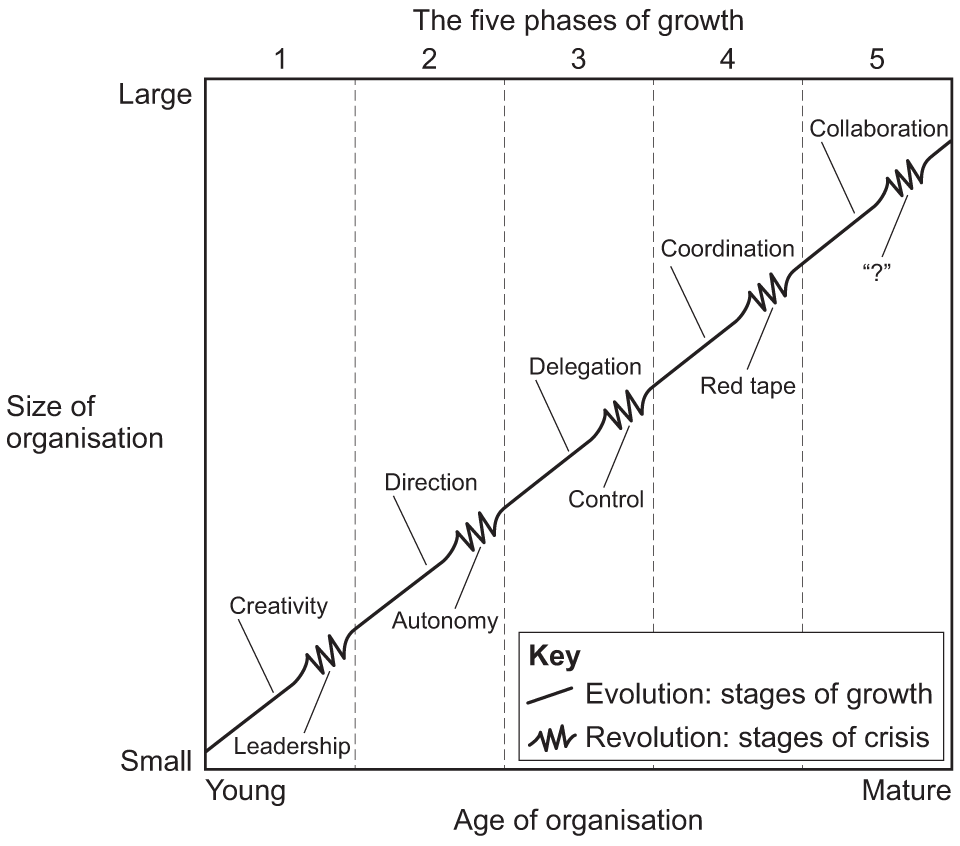Specifications that use this resource:
Teaching guide: Grenier's model of growth (for last exams in 2024)
Highlights the challenges that typically occur in managing businesses as an organisation gets older and bigger. It shows typical crisis points in the development of a business.
Model/theory

Key points
When organisations are young and small there is often no formal organisational structure. Sharing of ideas is easy and at this stage the organisation may be very creative. However, as a business continues to grow, this informal approach may no longer work – new employees may need more direction and need managing.
Crisis 1
At some point there is a need for direction and leadership which may not come naturally to those who founded the business and who are perhaps very entrepreneurial.
At this stage the business may need to appoint outside managers to run the business rather than rely on the founders. A more formal approach to management is required. For example, the managers may now formally define its missions, set out its objectives and formally define roles. They typically create a functional organisational structure and introduce more accounting systems and budgets.
This provides direction and control but there is little delegation. As the business grows more complex and those closer to the issues within their departments gain more experience they want to have more independence. This creates Crisis 2: a crisis of autonomy.
Crisis 2
At this stage the senior team may delegate more enabling each unit to focus more on its specific demands (although this is often resisted by senior managers who are reluctant to let go). The delegation provides more autonomy. It involves greater decentralisation and creating profit centres.
This can lead to faster decision making but, at some point, top management may feel they are losing too much control and want to regain this. This leads to Crisis 3: a crisis of control.
Crisis 3
At this stage the senior management team has to establish controls over the different parts of the business such as more formal planning procedures, greater control over investment decisions, centralising certain functions such as research and human resources and using profit sharing schemes more widely to help provide a common focus to decision making. The danger of this approach is that there may become too many procedures for decisions to be made by the different business units causing Crisis 4: a crisis of red tape.
Crisis 4
There may be too many systems and procedures getting in the way of competitiveness. This can lead to an attempt for greater personal collaboration between the managers of the different divisions and more focus on self control rather than imposed control from head office.
Greater discussion between the head office of other parts of the business and a shared approach replace some of the many rules. The focus is on team work across divisions, up to date information and more communication between senior managers.
However, Greiner highlighted this might lead to a further crisis at some point in the future although what it will be may vary, perhaps the impact on employees of working in such a demanding environment means some time will have to be given to employees to reflect and revitalise themselves.
When you can use this
- when analysing growth
- when considering how structures and systems might change as a business develops
- when examining issues such as centralisation and decentralisation
- when considering change and how it might affect a business.
Source: Larry Greiner, 'Evolution and Revolution as organisations grow', Harvard Business Review, May–June 1998
Where it's been used
-
Q9, A-level paper 1 2017
-
Q8, A-level paper 1, SAM set 1